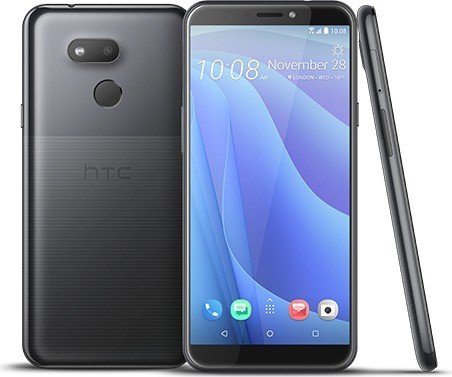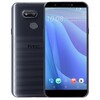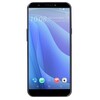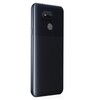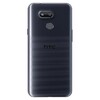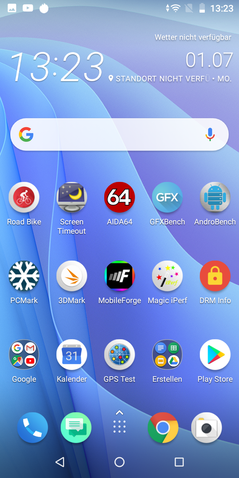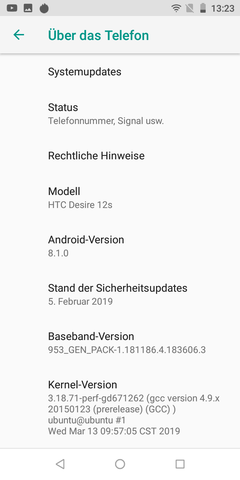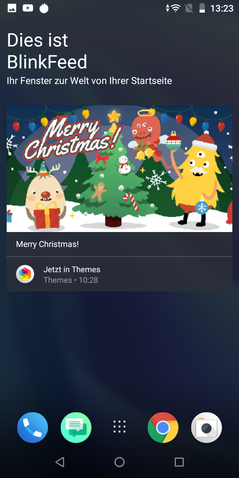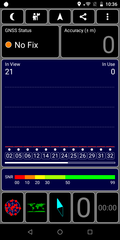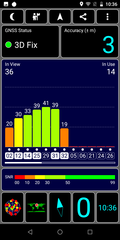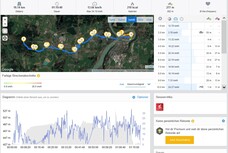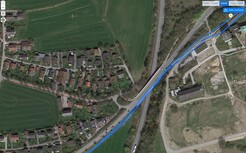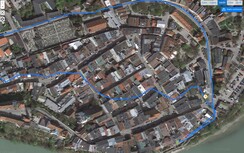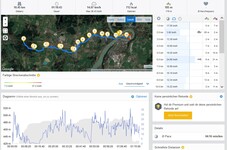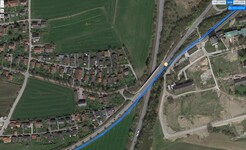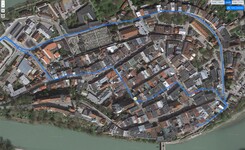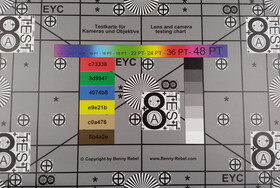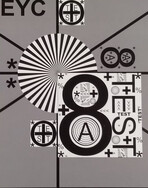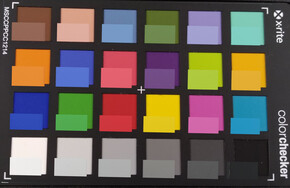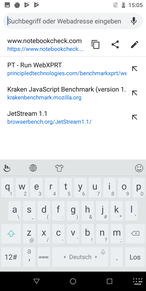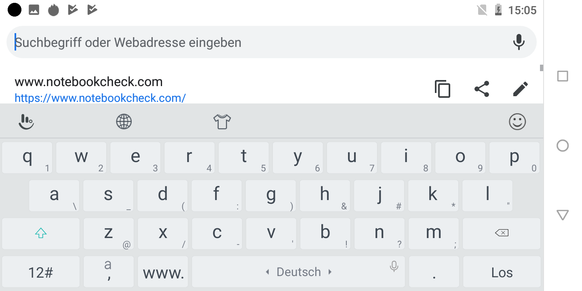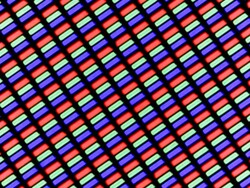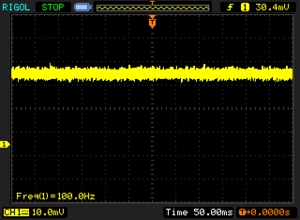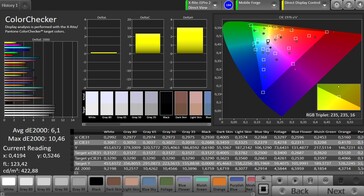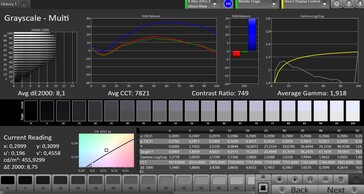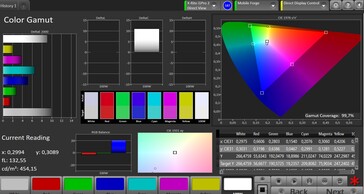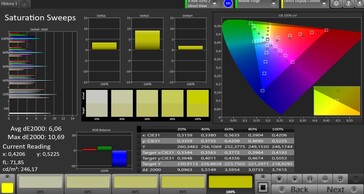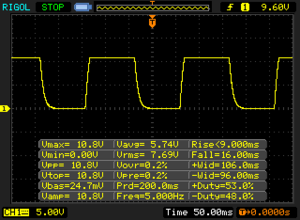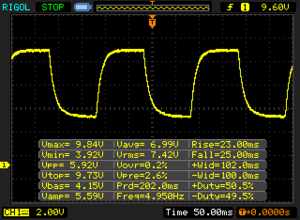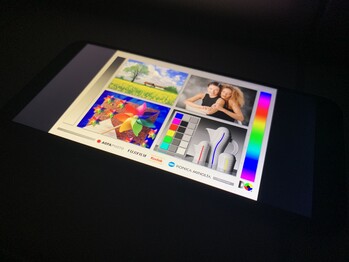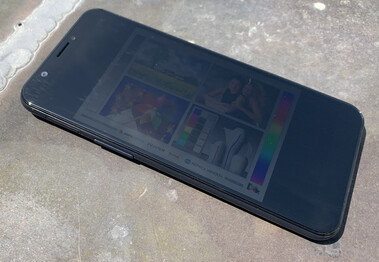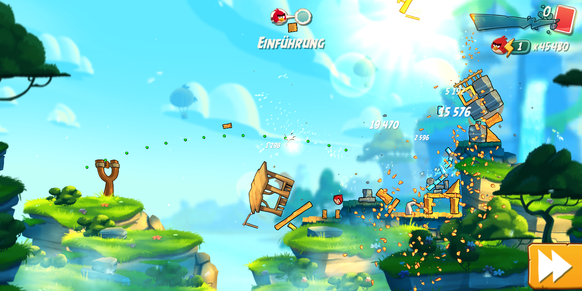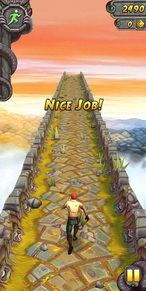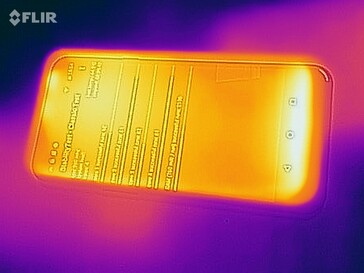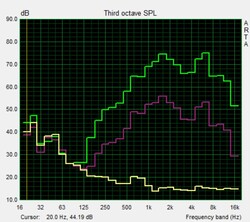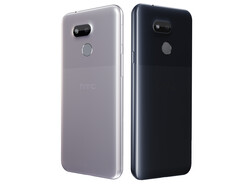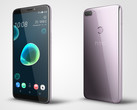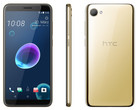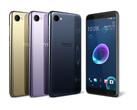HTC Desire 12s Review: Striped Smartphone
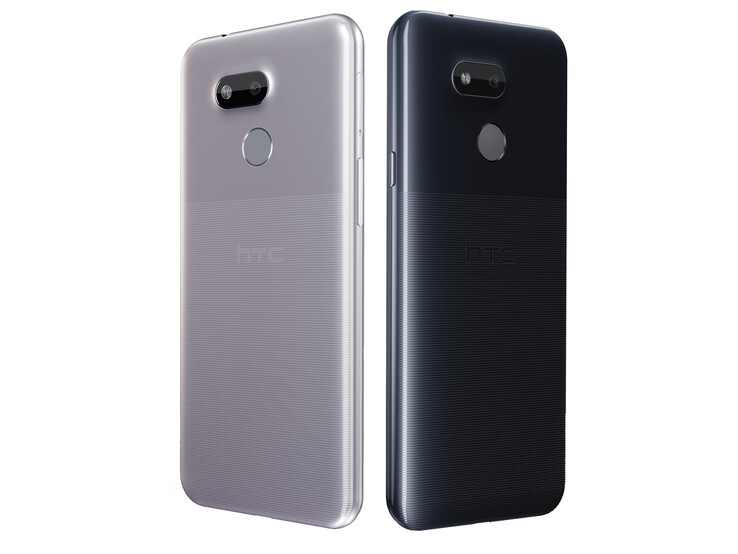
In the last few years, HTC has focused mainly on its premium range of smartphones in an attempt to woo customers with innovation. However, the company's line-up consists of more than just premium devices, as the newly introduced mid-range Desire 12s proves. For around $200 you get plenty of storage space, a fingerprint reader, and lower mid-range performance. Admittedly, that does not sound particularly enticing so let us find out whether or not the Desire 12s has any surprises up its sleeves.
Similarly priced competitors include the Nokia 4.2, LG K40, Sony Xperia L3, and the Huawei Y7 2019.
Case
The Desire 12s is available in silver-gray and black - not the most innovative of colors but a safe bet for sure. At least the plastic rear cover is far from bland, and the lower two-thirds are coated with a tangible striped pattern noticeably increasing the devices grip. Generally speaking though, the case is glossy and somewhat susceptible to fingerprints.
Its robustness is mediocre at best. Pressure from the front is quickly visible on the display. Pressure from the back resulted in some flexing but no ripples on the display. We were able to warp the case slightly, which produced visible distortions on the display.
The mid-sized device is not particularly heavy and too large for small hands. The top and bottom bezels are fairly wide, and unlike the Nokia 4.2 the HTC lacks a notch.
Connectivity
Two different storage tiers are available, albeit not in all markets. For example, European customers are limited to the 32 GB SKU with 3 GB of RAM while an additional 64 GB SKU is available in select markets as well.
While the device supports two SIM cards, the secondary slot has to share its precious space with the microSD card reader. The latter supports the exFAT file system but microSD cards can only be formatted as external storage, meaning they cannot be used to offload apps.
Software
Despite the long-time close cooperation with Google HTC has been lacking in the software department lately. For example, many flagship users are still waiting for updates, and the Desire 12s is anything but up-to-date either. Our review unit was running Android 8.1 with security patches as of February 2019. In other words it was outdated out of the box.
HTC’s Android skin is called HTC Sense, and it includes several changes to Google’s stock flavor of Android. For example, HTC Sense comes with a variety of preinstalled in-house apps that can only be deactivated but not removed completely. The same is true for some preloaded social media apps. Due to a lack of Widevine certification the device is incapable of streaming HD content from Netflix and the like.
Communication and GPS
In addition to all frequencies required for Central Europe the Desire 12s also supports a few additional LTE bands. However, we strongly advise you to do your due diligence before traveling abroad.
The Desire 12s does not support the 5 GHz Wi-Fi band and is therefore limited to 802.11n. When connected to our Linksys EA8500 reference router its performance was average for its class. The Sony Xperia L3 was much faster both ways and the LG K40 was faster receiving data. We did encounter disconnects during our tests and had to manually re-establish the Wi-Fi connection after waking the device from standby occasionally.
| Networking | |
| iperf3 transmit AX12 | |
| Sony Xperia L3 | |
| HTC Desire 12s | |
| Huawei Y7 2019 | |
| LG K40 | |
| Nokia 4.2 | |
| iperf3 receive AX12 | |
| LG K40 | |
| Sony Xperia L3 | |
| HTC Desire 12s | |
| Nokia 4.2 | |
| Huawei Y7 2019 | |
We use the GPS Test app to determine GPS accuracy. Indoors, we were unable to obtain GPS lock altogether. Outdoors it took a while but was very accurate at 3 m in return.
The HTC Desire 12s did fairly well in our on-road test on the overpass but was not particularly accurate around the narrow old town streets. In these cases it simply recorded a rough estimate of the track.
Telephony and Call Quality
HTC opted for Google’s stock easy-to-use telephone app that we are already familiar with. Carrier support presupposed VoLTE and VoWiFi are supported.
In general, we were quite taken with the Desire’s call quality. We had no issues understanding our conversational partners despite some minor distortions on maximum volume. Our voice was captured very clearly, and we had to make sure not to speak too loud in order to keep the microphone from over-modulating. When talking on speakerphone our conversational partner was loud and clear, and our voice was captured accurately regardless of volume.
Cameras
The HTC Desire 12s’s high-resolution 13 MP front-facing camera is a particularly noteworthy feature. The rear-facing camera also contains a 13 MP sensor. However, the selfie-camera is not as light-sensitive as the main shooter. As we all know resolution is not everything, and our sample photo is living proof thereof. Bright areas are overexposed, colors distorted, and details are visibly washed-out. The only positive effect is the camera’s brightening.
The main camera did much better than the secondary one, and it turned out to be well usable in daylight despite a noticeable lack of color accuracy and details. In low light the camera was incapable of capturing the darker areas, and the results were very noisy overall.
Videos are recorded in 1080p, and the camera reacts very quickly and smoothly to sudden changes in lighting. The amount of noise increases visibly in low-light scenarios. In bright light, the results are decent and acceptable.
When taken in our test lab and tested under normalized conditions, the test chart was not only visibly blurry but also showed uneven colors. In return, contrast was decent. The amount of blur increased slightly towards the edges, and colors were too dark overall.
Accessories and Warranty
Included in the box are a small charger (incapable of fast charging), a USB cable, a SIM tool, and a small and decent headset.
HTC devices purchased in Europe get a full 24 months of warranty.
Input Devices and Handling
The default keyboard is HTC’s TouchPal; however, it is not the premium version available in the app store. There are no ads and a wide variety of themes are available to customize the keyboard to your liking. Typing worked very well, and the keyboard is highly customizable. However, we were unable to change the keyboard layout to German despite adjusting the language settings accordingly.
The touchscreen is accurate up to its very edges and easy to use thanks to its smooth surface.
A fingerprint reader is located at the back of the device, which is very common nowadays for devices in the Desire 12s’s price range. The sensor works very reliably but suffers from a noticeable lag when unlocking the device.
Display
| |||||||||||||||||||||||||
Brightness Distribution: 92 %
Center on Battery: 459 cd/m²
Contrast: 765:1 (Black: 0.6 cd/m²)
ΔE ColorChecker Calman: 6.1 | ∀{0.5-29.43 Ø4.77}
ΔE Greyscale Calman: 8.1 | ∀{0.09-98 Ø5}
99.7% sRGB (Calman 2D)
Gamma: 1.918
CCT: 7821 K
| HTC Desire 12s IPS, 1440x720, 5.7" | Nokia 4.2 IPS, 1520x720, 5.7" | Huawei Y7 2019 IPS, 1520x720, 6.3" | LG K40 IPS, 1440x720, 5.7" | Sony Xperia L3 IPS, 1440x720, 5.7" | |
|---|---|---|---|---|---|
| Screen | 25% | 24% | 16% | 56% | |
| Brightness middle (cd/m²) | 459 | 445 -3% | 547 19% | 475 3% | 533 16% |
| Brightness (cd/m²) | 447 | 424 -5% | 543 21% | 467 4% | 533 19% |
| Brightness Distribution (%) | 92 | 91 -1% | 94 2% | 90 -2% | 89 -3% |
| Black Level * (cd/m²) | 0.6 | 0.26 57% | 0.49 18% | 0.32 47% | 0.25 58% |
| Contrast (:1) | 765 | 1712 124% | 1116 46% | 1484 94% | 2132 179% |
| Colorchecker dE 2000 * | 6.1 | 5.9 3% | 4.5 26% | 5.95 2% | 2.8 54% |
| Colorchecker dE 2000 max. * | 10.5 | 9.3 11% | 7.9 25% | 12.62 -20% | 5.1 51% |
| Greyscale dE 2000 * | 8.1 | 6.8 16% | 5 38% | 7.9 2% | 1.9 77% |
| Gamma | 1.918 115% | 2.2 100% | 2.35 94% | 2.331 94% | 2.11 104% |
| CCT | 7821 83% | 8443 77% | 7400 88% | 8202 79% | 6149 106% |
* ... smaller is better
Screen Flickering / PWM (Pulse-Width Modulation)
| Screen flickering / PWM detected | 100 Hz | ≤ 20 % brightness setting | |
The display backlight flickers at 100 Hz (worst case, e.g., utilizing PWM) Flickering detected at a brightness setting of 20 % and below. There should be no flickering or PWM above this brightness setting. The frequency of 100 Hz is very low, so the flickering may cause eyestrain and headaches after extended use. In comparison: 53 % of all tested devices do not use PWM to dim the display. If PWM was detected, an average of 8084 (minimum: 5 - maximum: 343500) Hz was measured. | |||
We found PWM flickering at brightness levels of 20% and below at a very low frequency of just 100 Hz. This frequency is so low that sensitive users will most likely suffer from headaches.
At 0.6 nits, the display’s black level is fairly high. Consequently, at high brightness levels, blacks are rather grayish instead. The resulting contrast ratio is a mediocre 765:1.
When measured with a spectrophotometer in combination with the CalMAN software, we found a very pronounced blue tint. Color deviations were okay overall; however, we should note that some smartphones in the HTC’s price range are much more accurate. Subjectively, colors seem somewhat pale.
Display Response Times
| ↔ Response Time Black to White | ||
|---|---|---|
| 25 ms ... rise ↗ and fall ↘ combined | ↗ 9 ms rise | |
| ↘ 16 ms fall | ||
| The screen shows relatively slow response rates in our tests and may be too slow for gamers. In comparison, all tested devices range from 0.1 (minimum) to 240 (maximum) ms. » 58 % of all devices are better. This means that the measured response time is worse than the average of all tested devices (20.2 ms). | ||
| ↔ Response Time 50% Grey to 80% Grey | ||
| 48 ms ... rise ↗ and fall ↘ combined | ↗ 23 ms rise | |
| ↘ 25 ms fall | ||
| The screen shows slow response rates in our tests and will be unsatisfactory for gamers. In comparison, all tested devices range from 0.165 (minimum) to 636 (maximum) ms. » 82 % of all devices are better. This means that the measured response time is worse than the average of all tested devices (31.6 ms). | ||
Performance
Qualcomm’s Snapdragon 435 is a very popular SoC for affordable mid-range smartphones. However, it is not particularly powerful, and consequently the HTC can be found at the bottom of our benchmark score lists more often than not.
The Nokia 4.2 and Huawei Y7 2019 in particular are both significantly faster than our review unit. Real-world implications include a noticeable lag when reducing or increasing volume while running demanding applications, or a general sluggishness when attempting to run two things at once.
| PCMark for Android | |
| Work performance score (sort by value) | |
| HTC Desire 12s | |
| Nokia 4.2 | |
| Huawei Y7 2019 | |
| LG K40 | |
| Sony Xperia L3 | |
| Average Qualcomm Snapdragon 435 (4316 - 5438, n=10) | |
| Work 2.0 performance score (sort by value) | |
| HTC Desire 12s | |
| Nokia 4.2 | |
| Huawei Y7 2019 | |
| LG K40 | |
| Sony Xperia L3 | |
| Average Qualcomm Snapdragon 435 (3538 - 3928, n=11) | |
| GFXBench 3.0 | |
| on screen Manhattan Onscreen OGL (sort by value) | |
| HTC Desire 12s | |
| Nokia 4.2 | |
| Huawei Y7 2019 | |
| LG K40 | |
| Sony Xperia L3 | |
| Average Qualcomm Snapdragon 435 (4.5 - 16, n=11) | |
| Average of class Smartphone (18 - 166, n=155, last 2 years) | |
| 1920x1080 1080p Manhattan Offscreen (sort by value) | |
| HTC Desire 12s | |
| Nokia 4.2 | |
| Huawei Y7 2019 | |
| LG K40 | |
| Sony Xperia L3 | |
| Average Qualcomm Snapdragon 435 (4.6 - 15, n=11) | |
| Average of class Smartphone (12 - 606, n=154, last 2 years) | |
| GFXBench 3.1 | |
| on screen Manhattan ES 3.1 Onscreen (sort by value) | |
| HTC Desire 12s | |
| Nokia 4.2 | |
| Huawei Y7 2019 | |
| LG K40 | |
| Sony Xperia L3 | |
| Average Qualcomm Snapdragon 435 (3.5 - 12, n=11) | |
| Average of class Smartphone (11 - 166, n=155, last 2 years) | |
| 1920x1080 Manhattan ES 3.1 Offscreen (sort by value) | |
| HTC Desire 12s | |
| Nokia 4.2 | |
| Huawei Y7 2019 | |
| LG K40 | |
| Sony Xperia L3 | |
| Average Qualcomm Snapdragon 435 (2.3 - 5, n=11) | |
| Average of class Smartphone (8.4 - 413, n=154, last 2 years) | |
| AnTuTu v7 - Total Score (sort by value) | |
| HTC Desire 12s | |
| Nokia 4.2 | |
| Huawei Y7 2019 | |
| LG K40 | |
| Sony Xperia L3 | |
| Average Qualcomm Snapdragon 435 (56672 - 59326, n=4) | |
When browsing the web the HTC Desire 12s was noticeably slower than its competitors. We took particular issue with the regular Wi-Fi disconnects that we did not experience with any other device.
| WebXPRT 3 - Overall | |
| Average of class Smartphone (38 - 380, n=30, last 2 years) | |
| Nokia 4.2 (Chrome 74) | |
| Huawei Y7 2019 (Chrome 73.0.3683.90) | |
| Sony Xperia L3 (Chrome 72) | |
| LG K40 (Chrome 74) | |
| HTC Desire 12s (Chrome 75) | |
| Average Qualcomm Snapdragon 435 (n=1) | |
| Octane V2 - Total Score | |
| Average of class Smartphone (2228 - 126661, n=194, last 2 years) | |
| Nokia 4.2 (Chrome 74) | |
| Sony Xperia L3 (Chrome 72) | |
| LG K40 (Chrome 74) | |
| Huawei Y7 2019 (Chrome 73.0.3683.90) | |
| HTC Desire 12s (Chrome 75) | |
| Average Qualcomm Snapdragon 435 (2689 - 3314, n=11) | |
| Mozilla Kraken 1.1 - Total | |
| HTC Desire 12s (Chrome 75) | |
| Average Qualcomm Snapdragon 435 (11007 - 13586, n=11) | |
| LG K40 (Chrome 74) | |
| Sony Xperia L3 (Chrome 72) | |
| Huawei Y7 2019 (Chrome 73.0.3683.90) | |
| Nokia 4.2 (Chrome 74) | |
| Average of class Smartphone (257 - 28190, n=154, last 2 years) | |
* ... smaller is better
When tested with our Toshiba Exceria Pro M501 reference card, the HTC turned out to be slightly slower than its competitors.
However, accessing the internal storage was fairly fast and the device was only outperformed by the Huawei Y7 2019. You will not get high-end smartphone storage performance but at least loading times should be noticeably shorter than on many other devices.
| HTC Desire 12s | Nokia 4.2 | Huawei Y7 2019 | LG K40 | Sony Xperia L3 | Average 32 GB eMMC Flash | Average of class Smartphone | |
|---|---|---|---|---|---|---|---|
| AndroBench 3-5 | -35% | 22% | -4% | -1% | 7% | 1439% | |
| Sequential Read 256KB (MB/s) | 286.9 | 220.4 -23% | 305 6% | 261.7 -9% | 290.9 1% | 242 ? -16% | 2235 ? 679% |
| Sequential Write 256KB (MB/s) | 105.6 | 18.17 -83% | 88.8 -16% | 100.5 -5% | 87.5 -17% | 100.5 ? -5% | 1871 ? 1672% |
| Random Read 4KB (MB/s) | 49.9 | 17.51 -65% | 83.5 67% | 52.6 5% | 28.83 -42% | 43.1 ? -14% | 297 ? 495% |
| Random Write 4KB (MB/s) | 11.4 | 4.31 -62% | 17.48 53% | 10 -12% | 16.36 44% | 22.3 ? 96% | 343 ? 2909% |
| Sequential Read 256KB SDCard (MB/s) | 79.8 ? | 86.7 ? 9% | 86.4 ? 8% | 77.6 ? -3% | 80.9 ? 1% | 71.8 ? -10% | |
| Sequential Write 256KB SDCard (MB/s) | 57.4 ? | 65.9 ? 15% | 65.8 ? 15% | 57.4 ? 0% | 61.7 ? 7% | 52.9 ? -8% |
Gaming
The built-in Adreno 505 GPU is capable of gaming, albeit limited to simpler games such as Angry Birds 2. Fast racing games, such as Asphalt 9, will require a faster and more expensive smartphone.
The orientation sensor and touchscreen worked flawlessly during games, which we tested by playing the endless running video game Temple Run 2.
Emissions
Temperature
Under load, the Desire 12s gets very hot. We measured up to 46.2 °C at the top, which is definitely too hot. When idle the device remained fairly cool.
(-) The maximum temperature on the upper side is 46.2 °C / 115 F, compared to the average of 35.2 °C / 95 F, ranging from 21.9 to 247 °C for the class Smartphone.
(±) The bottom heats up to a maximum of 43.8 °C / 111 F, compared to the average of 34 °C / 93 F
(+) In idle usage, the average temperature for the upper side is 29.6 °C / 85 F, compared to the device average of 32.9 °C / 91 F.
Speakers
The single mono-speaker is located at the bottom of the device, and it is loud enough to fill a small room. The soundscape is fairly balanced and neither highs nor mids are too pronounced. Overall, the resulting audio is acceptable for media consumption.
The device supports external speakers via Bluetooth and 3.5-mm headphone jack. Both worked flawlessly and produced clear audio.
HTC Desire 12s audio analysis
(+) | speakers can play relatively loud (82.4 dB)
Bass 100 - 315 Hz
(-) | nearly no bass - on average 66.9% lower than median
(+) | bass is linear (0% delta to prev. frequency)
Mids 400 - 2000 Hz
(-) | nearly no mids - on average 66.9% lower than median
(+) | mids are linear (0% delta to prev. frequency)
Highs 2 - 16 kHz
(-) | nearly no highs - on average 66.9% lower than median
(+) | highs are linear (0% delta to prev. frequency)
Overall 100 - 16.000 Hz
(-) | overall sound is not linear (123.2% difference to median)
Compared to same class
» 92% of all tested devices in this class were better, 7% similar, 1% worse
» The best had a delta of 11%, average was 35%, worst was 134%
Compared to all devices tested
» 97% of all tested devices were better, 2% similar, 0% worse
» The best had a delta of 4%, average was 24%, worst was 134%
Nokia 4.2 audio analysis
(+) | speakers can play relatively loud (87.1 dB)
Bass 100 - 315 Hz
(-) | nearly no bass - on average 34.8% lower than median
(±) | linearity of bass is average (9.9% delta to prev. frequency)
Mids 400 - 2000 Hz
(±) | reduced mids - on average 6.4% lower than median
(+) | mids are linear (6.4% delta to prev. frequency)
Highs 2 - 16 kHz
(±) | higher highs - on average 5.8% higher than median
(+) | highs are linear (6.3% delta to prev. frequency)
Overall 100 - 16.000 Hz
(±) | linearity of overall sound is average (25.9% difference to median)
Compared to same class
» 65% of all tested devices in this class were better, 6% similar, 29% worse
» The best had a delta of 11%, average was 35%, worst was 134%
Compared to all devices tested
» 79% of all tested devices were better, 4% similar, 17% worse
» The best had a delta of 4%, average was 24%, worst was 134%
Battery Life
Power Consumption
Power consumption is a mixed bag. On the one hand, idle and low-load consumption is pretty good. On the other, the Desire’s consumption under load is above average.
| Off / Standby | |
| Idle | |
| Load |
|
Key:
min: | |
| HTC Desire 12s 3075 mAh | Nokia 4.2 3000 mAh | Huawei Y7 2019 4000 mAh | LG K40 3000 mAh | Sony Xperia L3 3300 mAh | Average Qualcomm Snapdragon 435 | Average of class Smartphone | |
|---|---|---|---|---|---|---|---|
| Power Consumption | 8% | 18% | 12% | 24% | -33% | -25% | |
| Idle Minimum * (Watt) | 0.9 | 0.74 18% | 0.51 43% | 0.68 24% | 0.57 37% | 1.369 ? -52% | 0.847 ? 6% |
| Idle Average * (Watt) | 1.6 | 1.9 -19% | 1.7 -6% | 1.53 4% | 1.5 6% | 2.55 ? -59% | 1.448 ? 9% |
| Idle Maximum * (Watt) | 1.9 | 2.21 -16% | 1.85 3% | 1.95 -3% | 1.51 21% | 2.86 ? -51% | 1.633 ? 14% |
| Load Average * (Watt) | 4.6 | 3.04 34% | 3.17 31% | 3.5 24% | 3.09 33% | 4.38 ? 5% | 6.96 ? -51% |
| Load Maximum * (Watt) | 5.5 | 4.15 25% | 4.44 19% | 4.9 11% | 4.15 25% | 5.95 ? -8% | 11.3 ? -105% |
* ... smaller is better
Battery Life
At 3,075 mAh the battery is slightly larger than what we would consider to be standard for this class of devices (3,000 mAh). The Huawei Y7 2019 is particularly well equipped with its 4,000 mAh battery. Battery life is average overall. 11:29 hours in our Wi-Fi test is decent, and the device should survive two days of normal use.
The power supply does not support fast charging and takes around 2:30 hours to charge the battery from near empty to full.
| HTC Desire 12s 3075 mAh | Nokia 4.2 3000 mAh | Huawei Y7 2019 4000 mAh | LG K40 3000 mAh | Sony Xperia L3 3300 mAh | |
|---|---|---|---|---|---|
| Battery runtime | 1% | 62% | 8% | -7% | |
| WiFi v1.3 (h) | 11.5 | 11.6 1% | 18.6 62% | 12.4 8% | 10.7 -7% |
| Reader / Idle (h) | 39.2 | 35.5 | |||
| H.264 (h) | 15.6 | 12.5 | |||
| Load (h) | 4.9 | 4 |
Pros
Cons
Verdict
HTC’s flagships were once considered to be at the forefront of innovation, but the crestfallen Desire 12s is the exact opposite. The only feature that stands out is the striped pattern at the back. Otherwise, the 12s is nothing but an affordable run-of-the-mill mid-range smartphone. Its main problem is that other manufacturers managed to integrate much better hardware at the same price, be it bigger batteries and more performance (Huawei) or better connectivity with NFC and a dedicated microSD slot (Nokia 4.2).
What the HTC Desire 12s has to offer is a somewhat bright display, a somewhat accurate GPS, and a decent battery life. It lacks any highlights and suffers from a blue tint on the display, high temperatures under load, and aggravating constant Wi-Fi disconnects. HTC has to improve upon its software ASAP, and an update could be an easy way to raise the Desire 12s’s quality and value.
The HTC Desire 12s is a good-looking well-designed mid-range smartphone with too many issues, and ultimately it does not deserve our endorsement.
Considering the alternatives we cannot by any means give the Desire 12s our endorsement. Maybe we will once HTC updates the software to a more current and up-to-date version of Android and addresses the device’s Wi-Fi issues.
Note: Due to the annoying and permanent Wi-Fi disconnects we have reduced the overall rating by 2%.
HTC Desire 12s
- 07/01/2019 v6 (old)
Florian Schmitt




